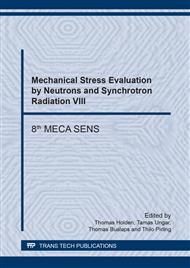p.107
p.114
p.123
p.131
p.137
p.143
p.151
p.157
p.165
In Situ Stress Measurements during Welding Process
Abstract:
Welding technologies are indispensable for fabricating various industrial structures and must be highly reliable. Since tensile residual stresses at surface after welding cause crack progress, it is important to understand how stresses built up during the welding process in order to optimize final residual stresses as reduced tensile or introduced compressive stresses. Therefore, we conducted in-situ measurements of phase transformations, stresses and temperatures during tungsten inert gas (TIG) welding to understand how stresses built up. X-ray diffraction rings were detected per 0.1 sec during TIG welding by using a large-area two-dimensional detector and the accuracy of the stress analysis was estimated to be 8 MPa using the sin2ψ technique. In this paper, we described the phase transformations of ferrite low-carbon rolled steel and the changes in stresses during TIG welding.
Info:
Periodical:
Pages:
137-142
Citation:
Online since:
August 2017
Price:
Сopyright:
© 2017 Trans Tech Publications Ltd. All Rights Reserved
Share:
Citation:


